Another day began with sunbeams spreading over the towers, turrets, cupolas, and steeples that surrounded us. We woke early in the gorgeous UNESCO city. After using the gym, we took advantage of our hotel’s daily breakfast. The dining area had three rooms, and each was usually full.
We preferred the room with windows overlooking the garden terrace.
On Saturdays and Sundays, most of the guests were Czech couples—young and old—enjoying a weekend in the capital. During the week, we also detected British, Chinese, and German accents. Each morning, it was a rousing sight to notice many Czech men enjoying the trend of tight-fitted T-shirts. (In the USA, it's usually only gay men who do it). They resembled this…
Meanwhile, the next generation of men in America still wear rumpled and saggy clothes that are too big for them.
Clothes with a trendy drape (or the Asian oversize look) is one thing, but that is a comparison of slobs versus “taking pride in your appearance”.
Two futuristic coffee/espresso/cappuccino machines kept customers caffeinated. There was an array of loose tea, drawstring teabags, and bowls of lemon rind, sliced ginger, honey, and sprigs of mint.
Pitchers of pulpy orange juice were next to bottles of Prosecco in ice chillers. We liked that detail, and many couples made festive or romantic use of it. Yes, sparkling wine was provided at breakfast every day.
Using the kitchen-towel that was provided, I grasped a loaf of freshly-baked bread and sliced a thick portion for the toaster.
Then, I smeared globs of blueberry preserves on it. Lovely! We bypassed the cereals...
...and we focused on a section of cold foods: creamy radish salads, spears of dill pickles, crab salad in phyllo cups, spiral rolls of sliced zucchini filled with hummus or olive tapenade, rolls of phyllo filled with smoked salmon and ricotta cheese. A big bowl contained Caesar salad with anchovies.
There were platters of sautéed mushrooms, baked eggplant, kugel casserole, and egg salad—with plenty of mayonnaise.
Four chafing dishes were always replenished with various sausages, bacon, scrambled eggs, sunny-side-up eggs, and crêpes with jam.
A neat row of hardboiled eggs sat in ceramic egg-holders. I chose one of the brown eggs.
Yogurt, sliced meats, wedges of Czech cheeses (cow, goat, and sheep), and seafood tapas were available. Chilled cups of fruit smoothies were ready.
Lewis and I liked the salt-and-pepper grinders that were on every table.
We prefer freshly-cracked spices, instead of the stale ones that come from shakers. *To understand that more, please use this link: https://halfwindsorfullthrottle.blogspot.com/2014/03/s-not-500.html
For guests who wanted dessert, there was an assortment of fruit-topped puddings, panna cotta, mini jars of tiramisu, petit fours, Swiss rolls, coconut brownies, soft cookies, fruit tarts, custard buns, and a Czech speciality named Honey Cake. Yum!
As you can see, every morning began with a feast to fuel us for the day. It is an excellent value for $140 per night.
[For comparison, when my British colleague visited NYC, he stayed at a Hilton Inn in midtown Manhattan on East 52nd Street. Despite being in a “big city”, the hotel lacked coffee during his first day. Coffee was out-of-stock: none in the rooms and nothing in the café. The hotel was uncaring and merely “apologized for any inconvenience”. The hotel didn’t order a delivery of coffee from the nearest coffeeshop (which would’ve been the simplest solution for its frustrated guests), nor did it issue vouchers for free coffee elsewhere. The hotel didn’t care. The next day, it had coffee, but it was out-of-stock of bacon for breakfast. My colleague was annoyed. The hotel didn’t offer any refund for its repetitive mistakes. It seemed like a joke to lack simple things like coffee or bacon; those seemed like third-world problems. Yet, that hotel overcharged for the privilege of being in NYC].
After eating, Lewis and I waved to the Front Desk team, and they hollered, “Hi guys! Have a great day!” A dutiful man alerted us that the British rock band, Depeche Mode, was in the city performing concerts. He warned us about crowds. We saluted his helpfulness, but we are overqualified to handle crowds; NYC suffers from overpopulation, protests, parades, mobs, and too much tourism. As the expression says, “If you can make it in New York, you can make it anywhere”. That’s true of us.
The morning’s air was brisk and pure. No exhaust from traffic congestion, stench of garbage piled on the curb, or dust from never-ending construction. It was a blissful way to start the day… which we sadly can’t do often in NYC.
We decided to start our day at the National Museum, so we rode a tram to Wenceslas Square.
We paused there to admire the sprawling square in daylight. Elegant, dignified, tree-lined, and vibrant with pedestrians, shops, restaurants, and orderly traffic.
We were still amazed that it was the invention of a far-seeing ruler, 700 years ago… and it’s still a vibrant part of the community. Clearly, Charles IV was ingenious.
Born in 1316 in Prague, Charles IV was born to be a king. He’s the most-famous Praguer.
His father was a count from the House of Luxembourg and the son of a Holy Roman Emperor. His mother was a Bohemian princess, from the royal House of Přemysl. His parents were married in 1310: his father was 14-years-old, and his mother was 18. Before her marriage, the princess lived at Prague Castle, yet her parents died of illness, six siblings died before adulthood, and her brother was crowned as the next king… but was assassinated by an unknown hater. (He was known as a “party boy” and suspected of being gay: always surrounded by young noblemen and was only married for four days before he abandoned his wife. He had no heirs).
Charles remained fond of his Bohemian lineage. As the eldest son, he was the heir-to-the-throne. His father was blind for the last ten years of his life, yet his keen senses kept him as a valiant warrior. He died in battle at age 50. In 1347, Charles was crowned as the next King of Bohemia. Prince-electors in Europe voted for him to become King of the Romans—to oppose a French-born Holy Roman Emperor. Initially, that opposition was costly and disastrous for Charles. Fortunately, the Frenchman died in 1349, and their war ended. By then, Charles’ 32-year-old wife died in Prague and was buried in St. Vitus Cathedral at Prague Castle. The next year, he married a 20-year-old Bavarian, but she died within four years. Still lacking a male heir, the twice-widowed monarch got married to a 14-year-old Polish noblewoman. She died at age 22 during childbirth and was buried in the cathedral, too.
In 1355, Charles was crowned as the Holy Roman Emperor and King of Italy. That year, he issued a royal proclamation so Prague became the capital of the Holy Roman Empire, which was hugely prestigious throughout Europe. Ten years later, Charles was also crowned as the King of Burgundy. In 1363, he married his fourth wife, a 16-year-old from Pomerania (her father was its duke). By then, he was 47. She was strong... supposedly able to break horseshoes. Their children became the next King of Bohemia, Margrave of Moravia, and Queen of England. The royal pair was strong and harmonious, and their family was sensible. Charles had a reputation as being peace-oriented and cunningly successful.
With his imperial authority, he decreed that Bohemian lands would endure regardless of dynastic changes or extinctions. His decree endured centuries. Officially, the Lands of the Bohemian Crown...
...included Bohemia (it’s still part of the nation), the Margraviate of Moravia (Moravia is still part of the nation), dozens of duchies of Silesia—each with their own duke (now mostly in Poland but one area remains part of the nation), as well as the Margraviate of Upper Lusatia and the Margraviate of Lower Lusatia (now in Poland and Germany). The coat of arms of the House of Luxembourg-Bohemia remains in use by the Czech government for the region of Bohemia.
Fortunately, Czech lands were unscathed by the plagues of the Middle Ages. Charles improved Prague with inspirations from Paris. To strengthen it, he founded Charles University in 1348 as the first one in Central Europe. It is one of the oldest universities, and it has properties throughout the city. He granted many scholarships that attracted intellectuals. Charles was a castle-builder who added eight to his realm.
To commemorate his reign, an image of the king is on the 100-crown banknote.
At the south end of Wenceslas Square, a City Gate either let people through the walls or kept them out. It was named Horse Gate because the square was popular as a horse-trading market. In 1875, it was demolished and replaced with the grandiose National Museum (initially named Museum of the Kingdom of Bohemia). It is a National Cultural Monument. We walked to the gargantuan museum, which is the largest in the republic.
Towering over the square, the Neo-Renaissance building began in 1885, and it contains most of the artifacts. An underground tunnel connects it to the museum’s second building: a repurposed office complex with Soviet-era qualities.
It simply named the New Building, and it gave the curators 3,000-square-meters of new space for their expanding collections. The museum has 14 million objects.
Before the notion of a museum, a Society of Patriotic Friends of the Arts was begun in Prague by noblemen in 1796. Surely, the devastation of the bloated French aristocracy that spurred the French Revolution—and liquidation of palaces—was a reason. In 1818, Prague’s National Museum was founded inside the Sternberg Palace, near Prague Castle. In 1820, Praguers excitedly welcomed Emperor Francis I and Empress Caroline Augusta for a six week visit. Every day involved social events and inspections of businesses, garrisons, orphanages, schools, hospitals, charity centers, music conservatories, and municipal organizations. He especially ratified the founding of the Museum, and it won royal patronage.
As we arrived, we saw springtime flowers that don’t exist yet in frigid NYC. An expanse of snowdrops looked pretty! Flowerbeds of sun-yellow daffodils and purple crocuses looked striking against bare-branched bushes. Shrubs with pink blossoms lined the staircases to the museum, and a tiered fountain gushed with water.
In 1968, the front façade was damaged by bullets from Soviet machine guns during the Warsaw Pact intervention. Locally, the protest was known as the Spring Uprising.
Signed in Warsaw, Poland, the Warsaw Pact was initiated by the Kremlin to resist NATO during the Cold War by forcing its Eastern Bloc nations to obey. However, Czechs wanted democracy and a decentralization of power from Moscow. Freedom of the Press began, so the KGB Secret Police hardened its stance in the nation. Fearful of anti-Soviet forces, Russia's army invaded Prague on the night of August 20, and it brought troops from its realms: Bulgaria, Poland, and Hungary. (East Germany, Romania, and Albania refused, and Communist China vehemently condemned the invasion). 165,000 soldiers and 4,600 tanks infiltrated the capital. 72 people were killed, and 266 were severely wounded. Despite the Soviet victory, the attack was the undoing of the Eastern Bloc.
Now, the scars prove Czech Resistance against adversity. Other than that, the museum is a beautiful place. For an ugly comparison, NYC’s biggest museum was never attacked, yet the it never finished its entrance. Uncaringly, blocks of stones still sit over its columns from 1902! Idiots!
We were much happier at Prague's museum. Inside the lobby, we encountered swarms of students. It seemed as if every school in the capital sent its pupils to the museum. At the e-ticket kiosk, we were confused by the English translation that implied “Buy a ticket for a tour, but every tour must end within two hours”. We questioned a mustachioed guy in a uniform, and he laughed about that misunderstanding. He doesn’t like the translation either. “Tour” meant self-guided tour, and he clarified that there is no time-limit. We bought tickets and paid an extra fee to see the “Baroque in Bohemia & Bavaria” exhibit. The cost was 400 crowns ($16.50) per ticket. We proceeded to the Grand Foyer.
The exhibition featured “everything Baroque” from the 1620s to the 1720s. 218 items were borrowed from dozens of collectors and institutions across Central Europe.
Some people perceive the Baroque era as part of the Dark Ages, but it was an era of vibrancy and embellishment. Furthermore, in the 1700s, a National Revival began in Bohemia that promoted Czech history, language, and culture.
Four halls were filled with sketches, clothes, architectural renderings, paintings, inventions, clocks, snuff boxes, and examples of Baroque lifestyles. The kingdoms of Bohemia and Bavaria were like workshops for Baroque ingenuity: fashion, construction, interior design, and travel. It’s understandable that Central Europe has a largely Baroque landscape.
Lewis liked the lifelike depiction of a horse head...
...and I noticed a Torah scroll topped with the imperial crown of Austria, made in 1767.
Since the 200s, Jews arrived in Austria, and they were initially respected by the Crown. Equal rights were documented in the 11th, 12th, and 13th centuries. Thanks to Emperor Frederick II in 1244, Jews focused on money-lending and finance. When Catholicism dominated the monarchy, an anti-Semitic milieu developed. In the 1400s, emperors cancelled debts owed to Jews, to restrict their revenue. In 1420, a Jew was falsely accused of desecrating sacramental bread, so Emperor Albert V arrested all Jews. The next monarch, Frederick III, cancelled that outrageous decree and let Jews live free of hate-crimes. During the reign of Empress Maria Theresa (1740-1780), religious tolerance prevailed, and that was the heyday of the Baroque period.
We ogled a card-playing table that had impressive scagiola: an Italian technique for making the appearance of faux marble on wood. Made in 1787, the table was an example of paint that imitated Florentine mosaics and the wavy striations of marble. The deck of playing cards are painted onto the table! So cool!
From there, we used the red-carpeted Grand Staircase to the upper levels. It’s an extraordinary staircase, with galleries that wrap around it—lit by rows of torchière lamps—and brightened by a gilded skylight. Marble banisters and balustrades add panache. Six-arm “globe lamps” illuminate each landing on the staircase, and people paused there to chat and take selfies. Please enjoy my panoramic video of it...
The famous sculptor, Ludwig Schwanthaler, chiseled statues of a famous royal pair, Princess Libuše and her husband (she predicted where Prague should be).
In other wings, we saw exhibits about prehistoric animals, underwater creatures, science, Czech history, and fabulous artwork.
Before the museum existed, the aforementioned Art Society was headed by a count named Casper Sternberk in 1796. He was a botanist who became the museum’s first trustee. Natural sciences gained popularity because they were favored by Emperor Joseph II, who was a monarch during the Enlightenment until his death in 1790. Thus, the museum still has prominent exhibits of them.
In one room, we studied the bewildering shapes of Renaissance-era instruments. In my images, those contraptions look like the precursors to the saxophone and tuba.
Made of carved bone, another instrument was a lute.
Heeled women’s shoes—covered with green fabric and silver brocade—identified the wearer as luxurious. Embroidered waistcoats—full of flowers and symmetrical squiggles—identified the wearer as affluent. Other rooms showcased medieval crossbows that evoked thoughts of William Tell.
A mechanical tortoise wowed us!
It was handmade by Johan Klein in the 1750s. A real tortoiseshell covered an antique mechanism that made paper-wrapped legs move. Klein was employed at the Clementinum to teach mathematics and physics. His enduring invention is still impressive.
We crossed the Atrium Café, which was decorated with dinosaur skeletons and modern androgynous fashion.
Using the elevator and two staircases, we ascended to the cupola that is on top of the museum.
We were 70 meters aboveground! The airy space is unknown to most tourists, but we discovered it by watching videos by Honest Guide, who can describe Prague in glowing ways.
Overhead, the cupola’s pyramidal roof was hollow and lined with wooden slats. It made a pleasant echo.
Please enjoy my video of the space...
A glass floor enabled an up-close inspection of the skylight dome underneath—that illuminated the Grand Staircase. A female face is in the center, and it’s made of stained glass.
The cupola has big windows, and we saw the landscape in every direction.
You can’t do that in Manhattan because constant construction of new (unnecessary) skyscrapers blocks views within a few years. The coolest view showed Petrin Hill sloping downward to the valley where Lesser Town is, with Prague Castle towering on the hill behind it.
Going downstairs again was equally magnificent.
In another foyer, we paused to admire the beautiful architecture. Made of polished brass, elegant torchière lamps illuminated intricate arches.
Looking up, we were amazed by four Art Nouveau frescoes on the interior of its dome. (Always look up in Prague).
My favorite one depicted Princess Libuše’s prophesy being fulfilled as her courtiers located the plowman whom she was meant to marry. Seen below, his name was Přemysl. I'll explain the backstory. The princess loved that man, but he was not a nobleman, so her councilors refused it. She agreed to make a second search. Using her magical gift of "seeing the future", she told them to release a horse and follow it until it found a man, and she would marry him. The animal stopped near a plowman in his field; it was Přemysl! Nobody could argue against Fate. Since her father bequeathed the dukedom to her as its next ruler, the courtiers welcomed the plowman into the royal family. He fathered the legendary Přemysl Dynasty of dukes, princes, and kings who wore the Czech Crown from the 800s until 1306. He instilled the values of being humble, remembering origins, respecting workers, and knowing that anybody could achieve high ranks.
Another one illustrated the first royal endowment of Charles University in 1347 by Emperor Charles IV and a papal bull by Pope Clement VI. After the one in Bologna, it was the second in the Holy Roman Empire, and it's one of the oldest in the world.
Lewis keenly observed small crowns on tops of the columns.
Going down a wonderful staircase, we looked up at the dome again. Lewis noticed the Crown of Saint Wenceslaus depicted repeatedly in the stained glass. In my photo, I circled them for you.
Next, we walked through the subterranean tunnel to the newer building. The tunnel is lined with video screens that display patriotic events.
In 1937, that building was the Stock Exchange, but in 1968, it was repurposed for the Soviet government that ruled the nation from Russia. (Technically, the Czechoslovakian legislature used the building, but it could merely approve edicts from the Communist Party). Our favorite exhibits were of anthropology and social behavior. Each decade was recreated with artifacts and vintage items of clothing, furniture, trophies, news blurbs, advertising posters, et cetera.
For the 1920s and 30s, interiors were remade to show how households that formerly employed maids repurposed the maid bedrooms as pantries. (Yes, servants were mistreated with tiny rooms near the kitchens). Nowadays, if you visit a prewar apartment that has a “large pantry”, it was probably intended as a “small maid’s room” in the 1910s. The Art Deco furniture and fashions were impressive, too.
Notice the crocodile women's gloves above. Prudce elegantní! (Fiercely elegant)!
Representing the War Years of the 1940s, rooms were constructed to show how Czechs made hidden compartments to hide spies who reported against the Nazis. They worked in tiny spaces with transistor radios and typewriters—often hidden behind hinged bookcases. Here is Lewis' video of one...
For the 1950s, there was a lot of pro-Soviet propaganda.
Trophies and pendants showed a mid-century focus on physical fitness and labor.
For the 1960s, furnishings showed how Czech households lagged behind the progress of “Western civilization”—lacking gadgets and relying on standard-issued (no-frills) products from Soviet factories.
That’s because Soviet ideals dictated that everybody should have the same things… except for the luxuries that Soviet leaders enjoyed—which was hypocritical and reminiscent of the czars whom they replaced. Sadly, the sink (above) looks better than thousands of sinks in NYC apartments, which are neglected since 1930 by uncaring landlords. Seen below are typical examples (yet rents for that mistreatment [how do you use two faucets to get even-temperature water?!] still cost $1,500+ per month)...
Home interiors of the 1990s evoked memories for Lewis and I: clunky computers, slow modems, CDs, DVDs, a Walkman with flimsy headphones, fliptop cellular phones, answering machines (with smaller size cassettes so you had to buy something different than regular ones), and the popularity of wood-veneer furniture (covering cheap particleboard). All of that chunky technology was a result of greedy conglomerates that had better merchandise but released it slowly so they could reap more profits and make customers wait—and endure malfunctions—longer. You might think of Microsoft, AT&T, RCA, General Motors, and General Electric.
Every June, Prague hosts a Museum Night, when 30 places offer free access to the public. This year is the 17th annual event, and it always includes food trucks, live music, and art workshops. Demonstrating its priority for culture, the city's transit system provides a specialized tram route and free bike rentals. Taxis provide discounted rides. Hooray for that.
We exited the museum and went to the famous statue of King Wenceslas on his horse, which faces the square that is named for him.
In 1887, it was sculpted by a Praguer named Josef Vaclav Myslbek. He eschewed his family’s urging to be a shoemaker, and he rewarded the nation with his creativity. The huge equestrian statue took him 20 years to complete. It is a National Cultural Monument. Uniquely, it honors a man who was a prince, duke, saint, and posthumously a king!
A spoof of it hangs in the passage of a nearby shopping center: Lucerna Palace. (That horse is upside down. We saw it when we explored the enclosed passages).
The real statue is always impressive: the nation’s patron saint is clad in armor to protect everyone. Please enjoy my panoramic video of the scene and turn the sound on...
As you repeatedly notice, Prague is a whimsical city! We also remind you to look up to glimpse the whimsical qualities that adorn fanciful buildings: beehives, nude figures with snakes, and verdigris-green men showing you their firm buttocks.
Proceeding along the square, we popped into Paul Bakery.
The French company began in 1889 when the Eiffel Tower opened. In 1953, it absorbed a larger patisserie named Paul, and it kept that name. Paul bakeries have ovens that operate in view of the customers.
Nearly 20% of the food is vegan. While many baking industries focus on (bleached flour) white bread, Paul relies on long-fermenting brown bread and authentic leavening ingredients. For example, malted wheat develops enzymes that modify its starches into fermentable sugars and modifies its proteins to be used better by yeast. (Malt is a grain that is partially germinated in water but then dried with hot air. It creates a deeper taste—tart citrus with crusty-bread flavors—that is ideal for whiskey, cereal, bread, bagels, beer, and Ovaltine. Malt contains potassium, dietary fiber, vitamin B6, and folates that lower your cholesterol and reduce insulin). Traditional recipes are mixed with innovation. The price of those mouth-watering loaves was only 75-105 crowns ($3-4.40) each. Nowadays, the company has many locations—from Czechia and Dubai to the island-nation of Singapore and the archipelago of Japan.
We selected a croissant—perfectly buttery yet flaky—filled with smoked ham, locally-made Brie, lettuce and tomato (99 crowns = $4).
Lewis got a Cheese and Sausage Quiche (same price). For something sweet, we shared a big Raspberry Eclair (129 crowns = $5.40)...
... and a generous slice of Rhubarb Tart—with a perfectly browned crust (99 crowns).
That was affordable for artisanal treats… and we loved it.
A local woman told us to visit the Central Post Office and the nation’s biggest bank because their interiors are grandly splendid. We went to the bank.
Headquartered in Prague, Česká Spořitelna is the nation’s biggest and oldest bank. It was founded in 1825 as a savings bank to help poor people manage their finances. A policeman named Josef von Hoch served on the Governor’s Council and submitted the proposal. To show solidarity, local princes, dukes, and counts deposited money, and business owners followed. The emperor and archdukes made big deposits. It is managed by the government, but in 2000, an Austrian bank became the majority stakeholder. The bank maintains the largest ATM network in the republic, and its charitable deeds are far-reaching in various aspects of daily life. Of interest to us was their Immigrant & Expat Center in their main branch on Rytirska. It is centrally situated between Old Town Square and Wenceslas Square. In 1732, the site was a theatre. In 1890, the space became a bank, and the Neo-Renaissance structure was designed by Antonin Wiehl and Osvald Polivka to have Italian flair.
During the Soviet regime, it was refitted as a museum about Czechia's first Communist leader named Klement Gottwald, whom everyone despised. Thankfully, the building resumed its intended purpose. However, it still maintains a public art gallery from its own art collection, as well as exhibitions about the history of money. Each year, 45,000 people visit the gallery.
We entered the grand entrance hall, and a fellow at the futuristic Front Desk directed us to go up the grand staircase.
I wasn't allowed to photograph them, but two bronze statues of nude young men with dogs were allegories of Vigilance. The famous Prague-born sculptor, Josefa Mauder, created them for the bank in 1905.
Mauder studied art in Prague and Vienna, and he toured Italy: Florence, Milan, Siena, Venice, and Rome. He supported young Czech artists. He was so talented that the City Council appointed him to the committee that critiqued proposals for structural ornamentation on buildings during the Belle Époque era.
Upstairs, we arrived in a glamorous space—expansive and surrounded by arcades of red marble pillars. Glass skylights gave plenty of brightness on the gold-plating.
I paused midway to use the lavatory. When I returned, a youthful gentleman named Jan (pronounced as Yahn) was chatting with Lewis. Lewis was curious about how Americans relocate to Czechia. Pleasantly unlike New York bankers, Jan escorted us to his office and invited us to sit in plush leather chairs for a non-aggressive conversation. He was polite and candid, and he gave details to our questions. He was never pushy with salesmanship, and there were high-margin items that he truly discouraged. Within a short time, our trio bonded, and Jan revealed that his husband is from Taiwan. Jan and Lewis discussed Chinese restaurants and markets in Prague. Inveigled by Jan’s manners and aptitude, we exchanged contact information. The entire experience was very impressive and earned our esteem.
From there, we hopped aboard a vintage tram coupé to our hotel.
We loved sitting in the curvaceous rear with a nice view through the curved windows. Despite its age, the interior was modern with new door mechanisms, ceiling panels, seats, railings, and a digital screen that announced upcoming stops. It amazed us. The tram was built in the 1960s (looking similar to this)...
Yet, it was refitted to be suitable for 2024.
In contrast, in pricier NYC, we are forced to use subway trains built in the 1970s that still have the same seats, worn-out floors (that curl up), non-functioning ventilation, (uncleaned) weak lights, repeatedly-breaking doors...
... and they do not have digital display screens (to see upcoming stations). That's absurd for the year 2024.
In the image below, look at the disgusting sign. The plexiglass signs have not been cleaned in years, and they are so dirty that their grime is only wiped away by people's heads! Gross!! It's like a third-world-country.
Yet, NYC’s transit is ten-times the cost of Prague’s! Can you imagine a place where passengers pay 10-times the price yet get dilapidated crap? Which would you want to use every day?
That night, we had tickets to a symphony concert. You may wonder why we attended two classical performances in the same week? It’s because Prague is a cornucopia of perfect classical music, and we wanted to see a variety. The people of Prague have often been more musically literate than folks in other places. Music Education is instilled in boys and girls during their formidable years. In the USA, public schools offer a passable program for vocals and instruments, but serious education is only received after additional expense at music academies. (If you want anything decent in America, you must pay twice the price). In Czech culture since the 1600s, Music Education is done with pride and aptitude, and its excellence is accessible to everyone.
Prague supports a wide variety of performances, including puppetry (skillful skits—not the nonsense that you see on American TV shows), marionette theater, and black-light theater (glow-in-the-dark illusions). Within the vastness of America, it’s hard to find any of those art-forms. In Czechia, troupes of performers make careers in those categories. Additionally, there are truly-talented street performers, musicians who play at cafés, and quartets who provide high-quality music at public squares. The capital keeps dozens of perfectly-preserved theaters, concert halls, and opera houses that succeed for centuries. Prague is blessed. If you’re going to Europe for music, you must witness Prague’s cultural perfection! We did.
We bought tickets to a concert at the Municipal House: the city's "pride and joy" concert hall. It has its own elegant restaurant, as well as an elegant café, pilsner pub in the cellar, and Europe’s oldest bar. Astute customers make reservations. We attempted to make a reservation at the restaurant (which needs 24 hours to be confirmed), but it was full, so the website cancelled it. Luckily, I had an alternate pinpointed in the area, so Fate steered us to a perfect meal anyway.
Riding the Metro, we returned to Namesti Republicky Station and ascended to the plaza.
We ate dinner in a gastronomic paradise! It is named Trezor Špork, and it is part of a larger restaurant named Červený Jelen (Red Stag).
The whole enterprise occupies a former palace of the noble Špork family from the 1700s. It is on Hybernska: a street that existed since the 1300s. Sweerts-Spork Palace is technically three structures that are now joined. On the west side, a Baroque palace from 1694 was built for Karel Jachym Breda. It was sold to a count named Frantisek Antonin Spork to be a theater in 1701. His grandson, Jan Sweerts-Spork bought the neighboring palace and connected both into one big palace.
On the east side, a Baroque palace stood from 1790.
In 1923, it was owned by a bank that added an extension. During WWII, Nazis occupied the nation, and their Gestapo took the building for offices. From 2011 to 2018, a massive reconstruction joined the buildings, and they are now named Spork Palace.
The restaurant is vast: 2,600-square-meters with 700 seats on four levels. The main level and its upper section are for Red Stag. Downstairs is the gastropub that offers nicer fare within the restaurant. On the lowest level is a brewery and beer bar. A shaft in the center has staircases and allows people to see all the levels.
We dined at the swanky gastropub, named Trezor (Vault) Špork (in honor of a count named Špork who built it). As you can guess from the name, it’s in the area that belonged to the bank. It was the large vault, and the armored door remains.
The restaurant’s supremacy was rewarded with Three Golden Lions (a perfect score) in the 2024 Best Restaurants Guide!
Golden Gastronomic Lions are awarded by a publishing company named TopLife Czech. Restaurants are assessed by anonymous inspectors. One, two, or three Golden Lions is a similar rating to Michelin Stars. The Czech Republic has a mild disdain for the covert influences (monetization) of the Michelin Guide, so it conceived its own system. One lion indicates excellent cuisine and friendly staff, but three lions proclaims that the restaurant has exceptional recipes—that are elevated to create an inspiring experience—and a highly-professional staff. When inspectors apply a TIP code, it means that the restaurant also impressed them with its value of a price ratio to quality.
The system reminded us of the Sol Repsol awards that Spain initiated as its own version of Michelin stars, which we experienced last year.
To guarantee a reservation, I telephoned from NYC to make the reservation one month before our trip, and a charming fellow confirmed it with ease. (Sadly, in overpriced NYC, most restaurants refuse to accept reservations earlier than 2 weeks. We prefer the nicer attitudes elsewhere).
Executive Chef Marek Fichtner is a Czech gentleman...
... who honed his skills in Copenhagen at Noma—repeatedly classified as the Best Restaurant in the World, with three Michelin Stars to prove it. *To learn about Noma, please use this link: https://halfwindsorfullthrottle.blogspot.com/2019/05/a-better-way-to-treat-kitchen-staff.html
In 2022, Chef Fichtner's culinary dexterities won the Gold Prize from Gastro & Hotel Magazine. In May, he’ll be involved in the Bocuse d’Or Competition in Prague! World-honored Chef Paul Bocuse began the global award ceremony in 1987 to highlight the precision of master chefs. Chefs compete in their own nation, then their continent, and then for a worldwide championship. *To see when we lunched at a culinary school with Chef Bocuse’s methodology, please use this link: https://halfwindsorfullthrottle.blogspot.com/2019/02/weekend-getaway-part-1-of-2.html
Chef Fichtner is respected for hiring more women than other kitchens, and he guarantees equal pay. As I said, we like to see equality in the hospitality industry.
It was a Thursday night, and our reservations were for 18:00 (6pm), yet the main restaurant was already half-full with chatty customers.
We were the first to arrive at the gastropub, but it quickly filled. Evidently, people leave their jobs promptly at 5pm and reward themselves with restaurants and pubs. That is Life/Work Balance.
A bearded fellow escorted us to a plush leather banquette. He was the maître d' and sommelier, so it was good that we met him first!
Chairs and tables were made of blonde wood.
We had a nice view of the beer-brewing tower and the bar downstairs.
Around the corner was the see-through kitchen.
Before I sat, I used the lavatory and encountered more undivided urinal troughs.
I joined Lewis at our table. The maître d' inquired about what drinks we wanted? In addition to a carafe of water, Lewis got an Orange Campari Negroni, and I requested a “botanical-tasting” Gin… but I got a Gin and Soda due to his misunderstanding. He seemed to be proud of what was concocted—involving a locally-distilled gin, so I drank it anyway.
In addition to the bar upstairs, there was a Service Bar on our level—which is a godsend for thirsty patrons. We like restaurants with that amenity; drinks can be swiftly delivered without the server having to wait for bartenders who are preoccupied helping customers.
As a paragon of culinary talent and knowledge, the kitchen sent an amuse bouche of beet-colored macarons filled with goose mousse, as well as tarts made with chilled domes of pork pâté—topped with Red Stags made of gelatin. Clever and scrummy!
Next, we received poppyseed buns and hand-kneaded whole wheat bread, alongside freshly-churned butter and spreadable lard. Superb.
After an appropriate time passed to imbibe our libations, a chubby Czech waitress took our food order. She was very nice and smiley with bright eyes. Lewis was keen to have the chef’s version of pan-fried Foie Gras in a sauce made with zesty kumquats, shallots, and tangy balsamic. It came with toasted slices of handmade baguette.
As another appetizer, we shared Lion’s Mane Mushrooms served in Marjoram sauce and Shitake purée, alongside a Barley Croquette dusted with shavings of Taleggio cheese. It’s amazing that mushrooms in Czechia are the best that we ever ate! Chefs respect them and find innovative ways to present them—full of earthiness, robust flavors, and just enough charring.
The food runner was a Russian gent, and he was happy to chat with us about the food. He was self-conscious of his accent, but we assured him that it was fine—and we amusingly indicated our own. He was a pleasure to interact with.
As a true professional, he was detailed to describe each recipe. Dutifully, he kept our water glasses full and used a mise-en-place tray to provide razor-sharp steak knives for our dinner.
For our main courses, Lewis wanted Hay-Aged Duck (breast, leg, and foie gras), alongside ricotta gnocchi, and braised red cabbage drizzled with Grand Marnier citrus sauce. When you dry-age duck meat, it creates a depth of flavor whilst retaining moistness inside.
As a fan of game-meat, I chose Loin of Fallow Deer. It was awesome!
As a bonus, another portion of the venison was prepared inside a Pithivier (meat pie glazed with egg-wash and decorated with puff pastry) with ragout. I love meat pies. It came with bitter endive and tart cranberries.
When the bearded man visited our table, I assured him that it was the tastiest venison that I ever had! It was better than the recipes I ate in Berlin, Oslo, NYC (at 2-Michelin-Star Aquavit and 3-Star Eleven Madison Park), Dallas (at the Four Seasons), London (at Rules), and Dublin (at 2-Star Patrick Guilbaud)! My eyes proved my sincerity, and he was noticeably enthused. He said that he would relay my compliments to the chef. I'm confident that they'll retain their 3 Golden Lions for many years.
Our deluxe dinner cost 2,923 crowns ($122.81).
It was a short distance on the same street to arrive at our next destination. The Obecní Dům (Municipal House) is splendid! It’s the largest and best-preserved example of Art Nouveau architecture in the world! It is a National Cultural Monument.
It occupies the place where coronation processions began for Czech monarchs because the space initially held the royal palace of King Wenceslas IV. He built it in 1380. The Municipal House retains the triangular shape of the palace.
As grand as it is, it competes for grandeur with the medieval Powder Tower that touches it.
With its imposing Gothic style, Powder Tower seems to guard the Municipal House. For fun, Lewis and I walked through its tall arch. The tower began as a City Gate in the medieval City Walls, so passing through it seemed appropriate.
The first version was built in the 1230s as part of the City Wall fortifications that protected a busy trade-route to Kutna Hory—a place with silver mines that funded the nation. When King Charles IV built New Town around Old Town, the gate lost its defensive importance. As the walls were removed, the City Gate remained as a tower, and it marked the border between Old Town and New Town. In 1475, the aldermen of Old Town voted to redo it. Clad in magnificent Gothic style, the restyled gate soared 42 meters into the air… which was high in that era of low buildings. In the 1740s, it served as a gunpowder storehouse for a barracks that stood where the concert hall is.
Due to the gunpowder, the tower was nicknamed "Dusty". During its restoration in the 1880s, it was given Neo-Gothic embellishments by an architect named Josef Mocker. Its height was raised to 65 meters, due to a swooping mansard roof. When the Municipal House was built, the city affirmed that the Gate should not stand alone, so a windowed bridge was built against it.
Lewis and I approached the concert hall. It was named Municipal House because it was a house "for the people". Every aspect is a gorgeous masterstroke of stylishness. In daylight, it looks like this...
The entrance is enhanced by a glamorous portico, made of stained glass in intricate geometric shapes. Every part has astounding intricacy and creativity!
Facing the city, a huge mural is titled “Homage to Prague”, and it was painted by a Czech named Karel Spillar (born in 1871).
Coated with a verdigris finish, a copper/glass dome crowns the front.
Two masculine statues hold multi-faceted globe-lights.
Its two front wings contain elegant eateries, so their windows always show happy customers being served by uniformed waiters.
The left side has the cafe: a brilliant masterpiece.
The right side has the elegant restaurant.
Downstairs, customers get refreshments at the Beer Hall...
...and Europe's oldest Cocktail Bar.
In 1918, the concert hall was used to proclaim Czech independence from the failing Austro-Hungarian Empire, and the same declaration announced the establishment of the Czechoslovak Republic.
At the entranceway, we already knew that the entire interior would be splendid because every detail was lovingly crafted.
In the images below, notice the details of the ceiling lights: symmetry, brass metalwork, and a geometric variety of pendants with enclosed lightbulbs around a chandelier.
Gilded figures seem to uphold the ceiling (with exposed nipples).
Over the doorways, stained glass is illuminated. Several Art Moderne clocks keep you on-time.
Inside the lobby, Lewis and I glanced everywhere to appreciate the craftsmanship! An antique “cage elevator” had a modern motor—all enclosed in its original marble casing.
Made with swirls, spirals, and symmetry, the brass chandeliers over the elevator door were beautiful.
We joined a crowd of Praguers who were all nicely attired and ascended a red-carpeted stairway—held in place by brass rods—and went through tall marble arches.
We glanced up at the elegant vaulted ceiling. A large window of stained glass and opaque glass added a pretty element to the stairway.
At the landing, there was a bar selling wine and beer. Behind it, a doorway was topped by two nude male figures who showed muscled butt cheeks and glanced at you over their shoulders.
That “nudity theme” continued up the next stairway, where a pair of naked women were angled to show their shapely buttocks, too.
Suited ushers were stationed in the corridor, and one of them glanced at our e-tickets and guided us into the correct doorway.
Suddenly, we emerged in the mammoth Smetana Hall—the largest of three halls in the building. It is incredible!
There are 1,259 seats, and standing is allowed at the rear balcony. The hall is named for Bedrich Smetana, who composed famous Czech music.
It was built in 1905 during the infancy of electricity, so it deliberately showed-off its lightbulbs. Rows of brass-encased lightbulbs accentuate the ceiling and its arches. They also encircle the oval-shaped skylight in the middle. Smaller skylights exist in front of it and behind it.
The opulent ceiling has brass vents with ornate Art Nouveau patterns.
The rectangular room has Box Seats on the main level, and open-air Box Seats above them. Six balconies exist, but the top two are used for spotlights.
Elegantly, the walls and ceiling are painted with Art Nouveau frescoes of allegorical themes. On the left, a scene seemed Greek: nude and partially-robed people sat on the grass listening to an orator.
Over the stage, a fresco featured a topless woman laying on a cloud, while a naked man approached with a strand of flowers.
To the right, two fully-nude women held hands and wrapped themselves in a cloak/blanket.
Beneath that, the arch was “upheld” by a half-naked man who resembled Adonis.
Every nook and cranny was covered with Art Nouveau embellishments: leafy garlands, female faces, vines, ribbons, and geometric squares with gold ones in expanding formations. Please enjoy my panoramic video...
At one time, most theatres and concert halls in Europe looked like this… but WWI and WWII destroyed many of them—depriving future generations of timeless splendor. We instantly understood why Czechs are proud and sentimental of their architecture gems. They need to be sustained. (NYC had similar halls but uncaringly neglected them and then let them get bought for demolition). We noticed people watching us—our necks craning upwards and all around with awe. Lewis blushed, and we decided that it was time to locate our seats.
The upholstery was white velvet, which looked gorgeous in the cream-colored interior, surrounded by plenty of white stucco. It was certainly representative of the Belle Epoch era. White material is also indicative of a clean society.
We love Czech affordability. The price of our symphonic concert—hosted in grandeur—was 650 crowns ($28) per ticket. In contrast, a concert in the bland concert hall of the NY Philharmonic costs $171 per ticket for a similar seat! That’s an appalling rip-off for the same type of seat. With NYC’s typical greed, an additional Processing Fee of 12% is added to the price for “the process and handling of your online order, as well as maintenance of the website”. A percentage-fee for tickets is pathetically stupid; how can a costlier ticket need more processing than a cheaper one? Clearly, it’s a scam to take more money from bigger prices. It discourages people from going. To make things worse, halls and theatres in NYC have notoriously small legroom… so you overpay for cramped conditions. We were glad to be away from that.
Nestled in our seats, we had a centered view of the stage. It was set for a full orchestral performance, and we noticed a big pipe organ at the back of the stage, with a chorus loft.
The Prague Symphony Orchestra filled the huge space. Founded in 1934 as the Film Opera Koncert (FOK), it is the official orchestra of Prague. Each season, it sustains 50 concerts! It tours around the world to spread classical music, and its musicians are global, too.
The orchestra performed splendidly, it was the most vibrant and vivacious ensemble that we ever heard in our lives. (That is why composers love Prague). Ion Marin was the conductor, and he was effervescent!
Before the concert, we noticed posters of him throughout the capital.
(Born in Bucharest, the Romanian is famous for his career in Vienna, partnering with the world’s greatest singers. In 2019, he was knighted with the rank of Commander for Romania’s National Order of Merit).
As a bonus, the musicians were joined by the Regimental Band of the Castle Guard & City Police. Very cool! Blending with the musicians, they wore formal "white tie" outfits: tailcoats, trousers with satin stripes, white vests, wingtip shirts, studs, white bowties, and cufflinks.
Hooray for collaboration and cameos!
The performance commenced with music by Johannes Brahms: Hungarian Dances #17-21, which was arranged by Antonín Dvořák. He’s a national celebrity.
Dvořák was born near Prague in 1841. As the son of a butcher, he proved to be a success story. He was talented with a violin at an early age of six! He entered contests across the Austrian Empire, and he won the Austrian State Prize for Composition in 1874 because Johannes Brahms—another pillar of classical music—was a judge who loved the young man’s work. He won repeatedly in 1876 and 1877. As a world-class composer, Dvořák’s music often incorporates folksongs and rhythms from Moravia and Bohemia. He taught as a professor at the Prague Conservatory of Music (founded in 1808 and still a strong institution), and he was its Director from 1901 until his death in 1904. Dvořák is buried in a cemetery at Vysehrad Fortress that is intended for famous artists, writers, composers, and scientists. There is a statue of him in the city-center, and his birth home was purchased by the Prince of Lobkowicz in 1884 for national preservation. His music endures forever.
The main segment of the concert was Sinfonietta. It was composed in 1926 by a Czech named Leos Janáček to express “a contemporary free man with spiritual beauty, joy, strength, and courage to fight for victory”. It has stentorian qualities of abundant percussion and brass that segues into lyrical parts for strings and woodwinds.
Some parts are fast and bracing. The fourth movement celebrates the newly-liberated Czechoslovakia with rapturous fanfares.
Its finale is a whirlwind of vibrancy. Clearly, the song is treasured by Czechs, and it’s amazing to hear. Perfect music in perfect ambiance!
During intermission, folks gathered at the bar or in several handsome rooms.
Things ended with Brahms’ Symphony #1 in C-minor, Opus 68, which was published in 1855. For it, that German mastermind wrote parts for timpani, bassoons, flutes, and oboes with great success.
Just like at the opera and our Mozart Dinner, the audience applauded for a wonderfully-long time. They stood and whistled. They cheered with the Czech equivalent of "Bravo"! Repeatedly, the conductor reappeared on-stage to point at soloists and various sections—queuing them to stand for recognition.
Unlike NYC, nobody rushed out of the theatre early—fearful of the challenge of getting transportation to go home. We stood with the joyful Czechs and clapped profusely for the talented instrumentalists. (That is "living in the moment" and not always being afraid of things going wrong). We could feel their rapture!
When the orchestra left the stage, everyone moved in orderly ways down the red-carpeted stairs to the Coat/Hat Check. It was the most orderly system that you can imagine. (In NYC’s overpriced theatres, Coat Checks are mandatory yet they forewarn you that they’re not responsible for anything that gets stolen. Once again, we were happy to be away from that).
Thrilled with the night’s entertainment, we were further thrilled to ride a clean Metro train to our hotel. In fact, just using an escalator that reached the street was a luxury for people from America.
At the underground station, transit workers cleaned the tiles, which was something that neither Lewis nor I saw happening in NYC during the last 40+ years.
Yes, simple things can be enjoyable, and smart people like us always remain grateful for them.
In our comfy hotel room, we watched Netflix movies that were filmed in Prague. The Gray Man was a 2022 American assassination thriller that filmed its murderous car/tram chase scenes in Prague. Just like with the real USA government, the American authorities who were proven to be guilty of mass destruction were released without punishment. Obviously, we disliked a film where insane actions have no consequences.
Art of Love was a 2024 Turkish film that featured a heist and car-chase in Prague. While watching, we uncorked the prince’s wine (it was delicious!) and snacked on Czech cheese from the grocer. It was a sublime end to a wondrous day.
Please join us in the next part as we venture through Vinohrady!










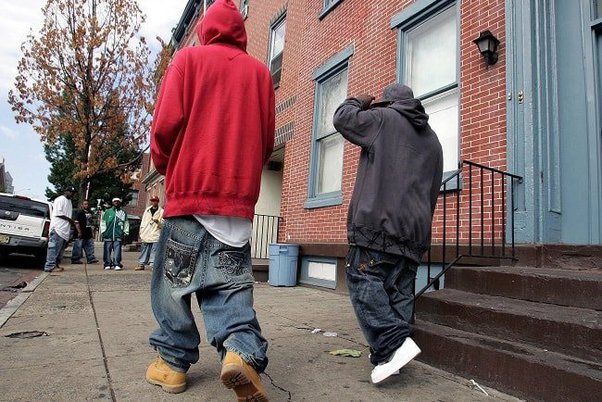




















.jpg)











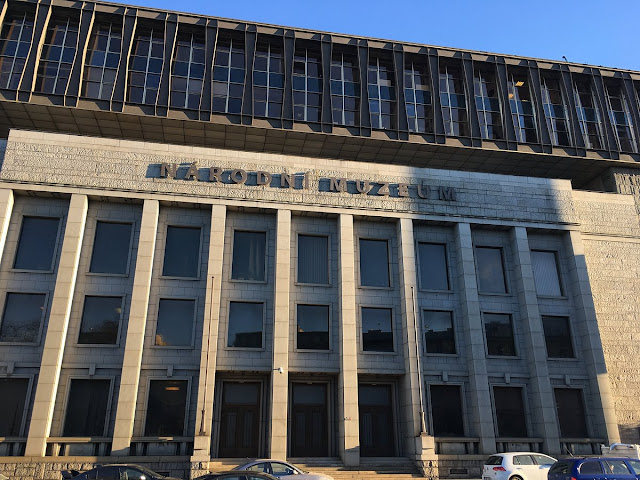






_(5).jpg)



















































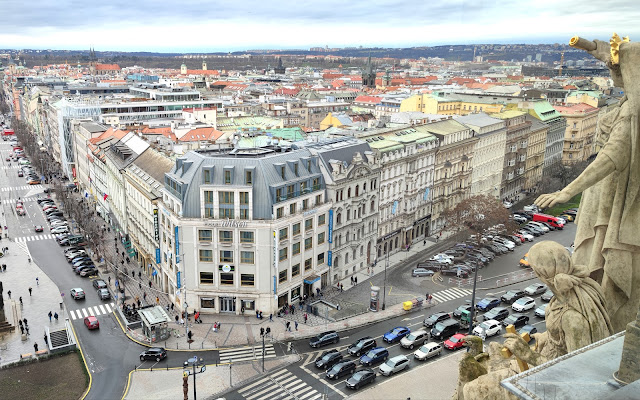










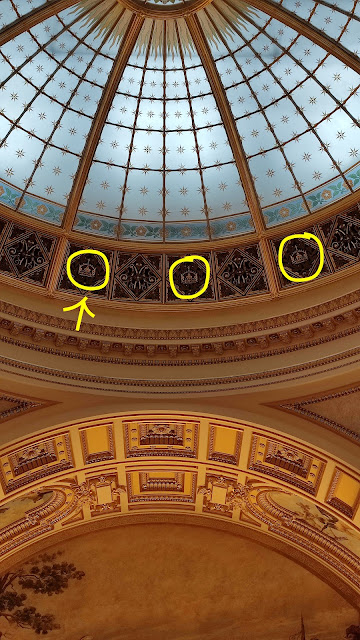





















































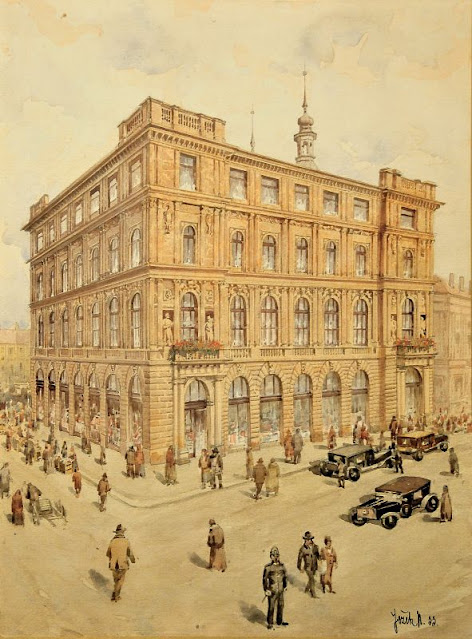



















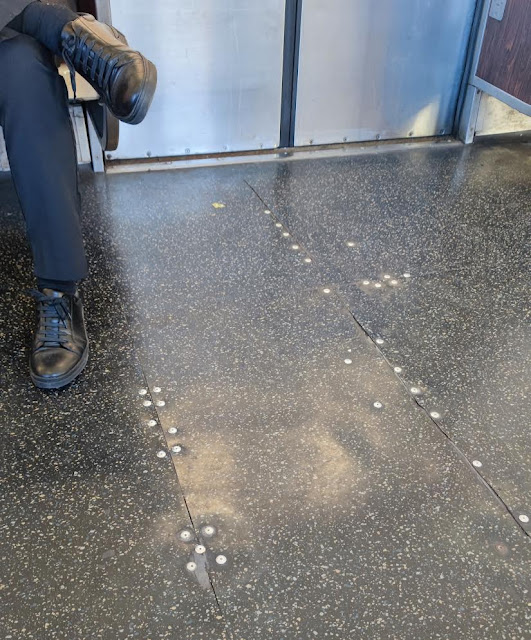
























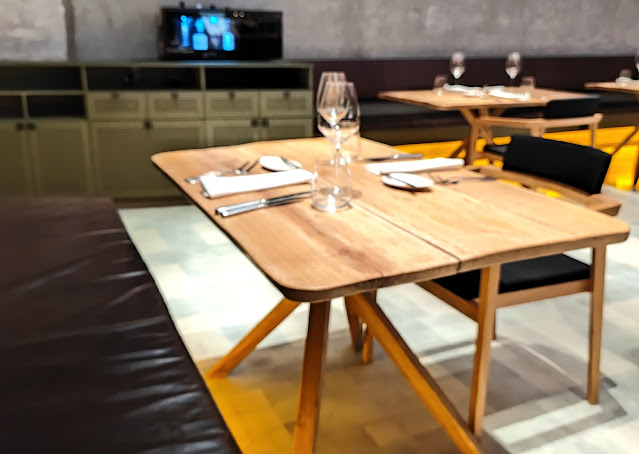






































































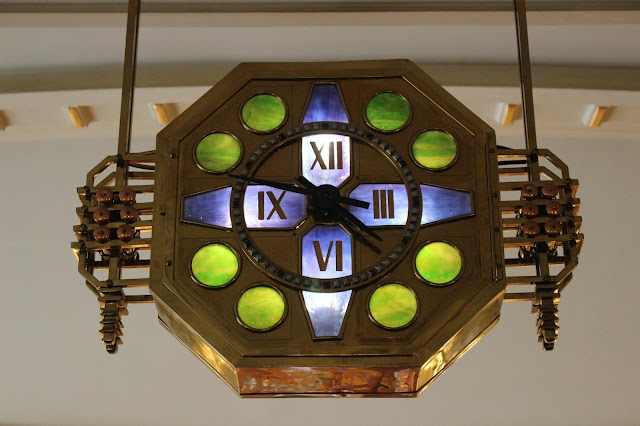





,_Prague_-_8860.jpg)




.jpg)






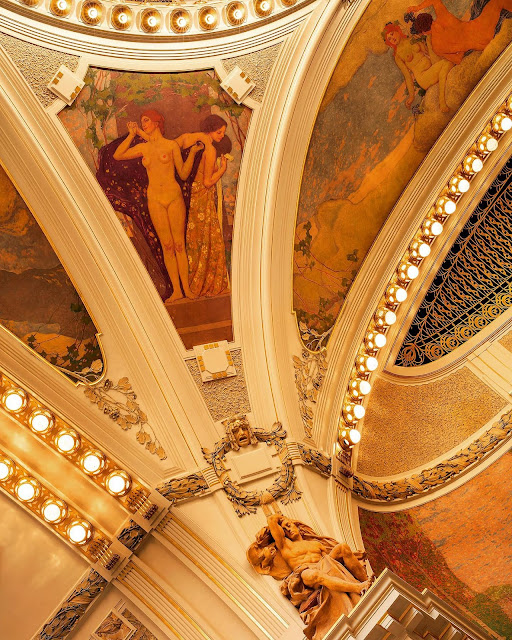

























































No comments:
Post a Comment
Don't be shy: leave your comments :)